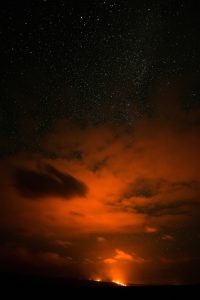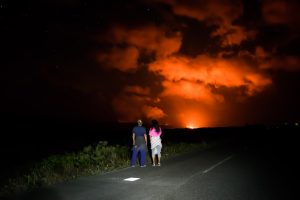Visitors: View Lava from Safe Distance

End of Chain of Craters Road within Hawai‘i Volcanoes National Park photo by NPS Volunteer Eric Fandrick.
The newest lava from Kīlauea volcano is drawing many visitors to Hawai‘i Volcanoes National Park, as flows from Pu‘u ‘Ō‘ō vent in the east rift zone stream down the Pulama Pali, spread onto the coastal lava plain and advance toward the Pacific.
Although portions of the flows are within the park, the closest viewing is from the County of Hawai‘i Kalapana Lava Viewing Area off Highway 130, near the eastern border of HVNP.
The viewing area is open daily from 3 to 9 p.m.
From the park side, the easiest vantage point to view the flows, dubbed “61G” by the USGS Hawaiian Volcano Observatory, is at the end of Chain of Craters Road, past the Hōlei Sea Arch, where the pavement ends and the gravel emergency access road begins.
The park is open 24 hours a day.
Park rangers do not encourage visitors to hike out to the lava flows from either side, but to instead view them from a safe distance.

End of Chain of Craters Road within Hawai‘i Volcanoes National Park photo by NPS Volunteer Eric Fandrick.
From the park side, hikers can expect a difficult 10-mile roundtrip hike over very uneven and sharp lava rock terrain riddled with cracks. There is no trail, and it’s easy to get lost after dark.
“There’s definitely been an increase in injuries since the 61G lava activity amplified,” said Chief Ranger John Broward. “We responded to calls about turned ankles, lacerations, dehydration and disoriented visitors in the coastal lava plains all weekend. It’s exceedingly important to plan ahead, have proper footwear, and bring plenty of water, or better yet, enjoy the show from the end of the road on either side.”
Volcanic gas is another hazard, particularly to people with heart or respiratory problems, and infants, young children and pregnant women. If air irritates smells bad or makes breathing difficult, Broward said visitors should leave the area.
Although hikers are walking along the gravel road constructed as an emergency access route to access the flows, park management does not encourage its use.
Download or hiking tips here.
For the latest eruption updates, visit the USGS Hawaiian Volcano Observatory website.
Monitor air quality at online.
RELATED LINK













